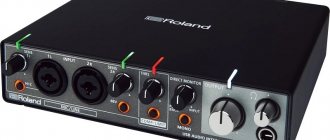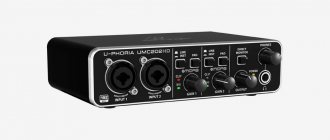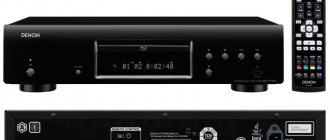Integrated sound cards of modern motherboards fully cover the needs of ordinary PC users, however, their capabilities, as well as the quality of the reproduced sound, leave much to be desired. Their operation uses computer resources, which significantly reduces performance; they are affected by electromagnetic interference, which leads to the appearance of extraneous noise. Discrete audio interfaces do not have such disadvantages, which allows them to be used for professional sound recording and processing. Also, these devices significantly improve the quality of the reproduced audio, and this is especially noticeable in conjunction with professional acoustics.
The rating below presents the best models of external sound cards, with which any work with sound reaches a new level.
Summary table of external sound card characteristics
Compare the capabilities and prices of current audio card models and choose the one that suits your purposes.
| Name | Connecting to devices | Purpose | Connectors and interfaces | Peculiarities | Manufacturer country | price, rub. |
| BEHRINGER U-Control UCA222 | PC, laptop | Recording, listening to music | RCA, TRS, MIDI, USB, XLR, S/PDIF | Compatible with Android devices | Germany | 1700 — 2700 |
| Behringer U-PHORIA UMC22 | PC, laptop | Recording, listening to music | RCA, TRS, USB, XLR, S/PDIF | Easy installation | Germany | 3400 — 5000 |
| ASUS Xonar U7 MKII | PC, laptop | Recording, listening to music | RCA, TRS, MIDI, USB, XLR, S/PDIF | Supports audio playback through 7.1 system | China | 6 500 — 7 300 |
| Creative Sound BlasterX G5 | PC, laptop | Gaming | RCA, TRS, MIDI, USB, XLR, S/PDIF | Low noise level | Singapore, China | 11 000 — 13 000 |
| Roland Rubix24 | PC, laptop, tablet | Recording, listening to music, gaming | RCA, TRS, MIDI, USB, XLR, S/PDIF | Supports audio playback through 7.1 system | Japan | 12 000 — 15 000 |
| Steinberg UR22 | PC, laptop, tablet | Recording, listening to music | RCA, TRS, MIDI, USB, XLR, S/PDIF | to connect to the tablet you need a Camera Connection Kit or Lightning to USB Camera Adapter | Germany | 13 000 — 15 000 |
| Focusrite Scarlett 2i2 2nd Gen | PC, laptop | Recording, listening to music | RCA, TRS, MIDI, USB, XLR, S/PDIF | Compatible with GNU/Linux | Great Britain | 14 500 — 17 000 |
| Native Instruments Komplete Audio 6 MK2 | PC, laptop | Recording, listening to music | RCA, TRS, MIDI, USB, XLR, S/PDIF | included keys for activating programs and plugins: Maschine Essentials, Replika, Solid Bus Comp, Modpack, Phasis, Monark, Komplete Start, Traktor LE 3, Ableton Live Lite | Germany | 16 000 — 20 000 |
| Audient iD14 | PC, laptop | Recording, listening to music | RCA, TRS, MIDI, USB, XLR, S/PDIF | Supports audio playback through 7.1 system | Great Britain | 19 000 — 22 000 |
| Zoom UAC-2 | PC, laptop | Recording, listening to music, gaming | RCA, TRS, MIDI, USB, XLR, S/PDIF | Easy setup | USA | 18 000 — 26 000 |
Expert opinion
Maria Poluyanova
He understands topics related to music, sports, motherhood and childhood.
Ask a Question
All external sound cards in the rating are compatible with current versions of Windows and MacOS systems. Some even work with mobile devices on iOS and Android. Evaluate which option is right for you for working with music or gaming.
Zoom UAC-2
Third place in the TOP 10 external sound cards was taken by a universal model with high performance. The dual-channel device is compatible with computers running Windows/MacOs.
Connection method: via USB port (2.0/3.0), compatible with tablets, including Apple models. SuperSpeed technology allows you to minimize time delays in audio signal transmission.
Zoom UAC-2 is able to work with almost any external sound source, including a microphone or musical instruments, conduct media presentations, game broadcasts - in a word, work in real time.
There are no unpleasant effects such as signal jitter in antiphase, so there is no need to use external clock generators.
The front panel includes two combined XLR/TRS inputs, allowing you to connect different audio sources. The outputs are designed to connect an amplifier or active speakers. There is a 1/4″ stereo jack with its own volume control.
Advantages of the Zoom UAC-2 card:
- small dimensions;
- build quality;
- good functionality;
- the ability to connect a large pool of sound sources;
- There is a signal processing function, recording via Loopback.
The downside is that when you turn off the computer, the device continues to work. The problem can be solved by BIOS settings, if present.
How to choose a sound card
There are few criteria for selecting equipment. Even with a small budget, you can identify several suitable models and choose the best one from them.
Purpose
First, decide on your goals. You don't need overly expensive external cards to play computer games or listen to music. For example, gamers will appreciate:
- Creative Sound BlasterX G5
- Roland Rubix24
- Zoom UAC-2
Suitable for recording music:
- BEHRINGER U-Control UCA222
- Behringer U-PHORIA UMC22
- ASUS Xonar U7 MKII
- Roland Rubix24
- Steinberg UR22
- Focusrite Scarlett 2i2 2nd Gen
- Native Instruments Komplete Audio 6 MK2
- Audient iD14
- Zoom UAC-2
For music lovers, in principle, any audio card from the rating is suitable; my personal recommendation is to exclude the most expensive models with a large number of knobs.
Price
Even with a small budget you can buy a high-quality audio card. Just be prepared that their functionality will be limited.
In any case, beginning musicians and sound engineers will need little functionality and cheaper models. As you develop professionally, you can sell old cards and buy more powerful and expensive ones instead.
Brand
It is generally accepted that Behringer produces low-quality external sound cards, while Roland, Steinberg and Native Instruments produce professional ones. In fact, both brands have both budget models with a minimal set of functions and expensive “monsters”. Focus on functionality and your needs.
Connectors and interfaces
RCA, or “tulips” - for connecting some types of audio equipment.
TRS, or Jack (there are 3.5 and 6.5) - connectors for connecting instruments, microphones and amplifiers. Most often I meet them.
XLR - usually combined with TRS. These are balanced inputs and outputs for connecting professional-level microphones.
MIDI is a data transfer interface, not all sound cards have it. Suitable for creating and recording music.
S/PDIF - optical connector. Used to connect multi-channel audio systems (5.1, 7.1).
USB - used for power and data transfer.
Accessories
Amplifiers, like everything else, must correspond to the class of the sound card. A system with too much power or too many inputs (for example 7.1) may experience interference if the card is not designed for it.
Microphone - Condenser devices are preferred for sound recording.
Cables are needed to connect music and recording equipment. Gaming computer hardware usually has them built-in.
For sound recording, choose thick cables: they have better insulation, which means additional protection from noise.
Headphone impedance must match the class of the card. The cheaper the audio interface, the lower the headphone rating should be, otherwise the sound will deteriorate.
Expert opinion
Maria Poluyanova
He understands topics related to music, sports, motherhood and childhood.
Ask a Question
If you record sound at home, especially from a guitar, take care of soundproofing. Even during the daytime, the noise level in an apartment building should be within such limits that neighbors cannot hear it. It is enough to separate part of the room and cover the walls with specialized materials (acoustic foam, felt, etc.).
Creative Sound BlasterX G5
This model was included in the rating of external sound cards connected via USB not because it belongs to a brand that was once a household name for all sound cards, but because of its real consumer characteristics. In our review, this is one of the most compact devices, but at the same time it has remarkable functionality. Connecting to a computer/laptop is extremely easy, and the sound quality is decent, regardless of the source, which can be a game console. There is no built-in hardware microphone or similar “tricks”, which influenced the price tag downwards.
The plastic prismatic body looks stylish and modern; on the front there are two outputs - for headphones and a microphone. The volume control is located on the side, it is large and convenient. The front part has a layer of velvety anti-slip polyurethane.
Main advantages of Sound BlasterX G5:
- compact dimensions;
- good build quality;
- nice design;
- high performance;
- long service life.
Among the disadvantages, the most serious is the possibility of background noise when using a pair of powerful speakers.
Which is better: external sound card or DAC?
The choice between a digital-to-analog converter and an external audio card, as in the case of choosing a keyboard musical instrument (synthesizer, electronic piano or midi keyboard), depends on your goals. So, the DAC is suitable for music in 2.0 format. These devices do not have connectors for connecting microphones, 4.1, 5.1, 7.1 systems, etc. In other words, with them you can only listen to two-channel stereo sound.
Software for the DAC is either not needed or required in a minimal amount. Actually, for such modest purposes this is logical.
An external sound card is more difficult to set up; it usually comes with a hefty set of drivers, and there are a lot of knobs on the case itself, especially if it is an audio card for recording. Everything is provided for the most detailed setup of work.
There are two-in-one devices. Typically, a sound card with an integrated DAC is inferior to a set of a separate converter and a separate card: noise from the operation of adjacent parts is superimposed on the reproduced or recorded sound.
Audient iD14
The British external sound card for games is in the TOP 10 in seventh place. This is a fairly compact product that you can take with you on the road. High mechanical strength is ensured by the metal body, and there are anti-slip rubberized feet. The audio card, characterized by extensive functionality, can be used in a home recording studio - it has four outputs, two line outputs and the same number of microphone outputs, and an instrument input (10 inputs in total). Audio sampling is at 96 kHz. The universal set of functions provides excellent output sound quality, almost indistinguishable from more advanced full-size devices.
Not all competitors have Class A microphone preamplifiers; it is possible to connect the entire range of musical instruments, from an electric guitar to the simplest ones equipped with a primitive pickup.
Among other functions, we highlight a DSP mixer characterized by minimal latency. The iD ScrollControl function is designed to connect iTunes libraries, allowing you to manipulate plug-in parameters. Power is supplied from the USB port or using the included external adapter.
Main advantages of the card:
- Excellent sound for this price class;
- stable operation of software and hardware;
- various functionality;
- convenient adjustment handles.
The obvious disadvantage is the low volume of the headphone output.
Which is better: an external sound card or an internal one?
The built-in sound card is usually intended for listening to music and for computer games with low system requirements.
To record music you need audio cards with higher performance. In addition, internal devices pick up noise from other parts of the computer located nearby, which will inevitably affect the sound quality.
Music lovers and gamers also note that with the internal audio card the sound leaves much to be desired.
Is your external audio card not included in the rating? Tell us in the comments what model you have and why you chose it.
Focusrite Scarlett 2i2 2nd Generation
Choosing an external sound card for a small home studio would be incomplete without a second-generation model from Focusrite. This device has a metal body, under which the latest microphone converters and amplifiers are located. With minimal signal transmission delay, the card supports audio sampling at a frequency of 192 kHz.
The product looks nice, the controls on the front panel are knurled, making it easy to fine-tune the sound, which is already of high purity and quality.
The converters are characterized by a dynamic range of 110 dB, a time delay of about 2.75 ms, allowing you to work with the device in virtually real time, this applies to playback, recording, and monitoring.
There is built-in protection of analog circuits from unstable voltage. The proprietary Focusrite Creative Pack software package includes, in addition to the main functionality, 12 additional plug-ins.
Advantages of the model:
- compact dimensions;
- high-quality sound recording;
- minimum time delay;
- no noise when recording sound.
As some users note, the card sometimes freezes, but this does not happen often.
Tascam US-2x2
Despite its venerable age (the product was released in 2014), the model turned out to be surprisingly tenacious, so its inclusion in the TOP of external budget sound cards is not an accident.
The main advantage is the excellent quality-to-cost ratio. The device has two Mic/Line outputs that are compatible with XLR/TRS connectors. So you can even use high-quality condenser microphones. Each of the connectors can be used to connect tools; the corresponding switch is located on the front.
There is a classic format headphone output (6.3 mm). There is a pair of balanced linear outputs. The card allows you to play and record sound with a bit depth of 16 or 24 bits, the frequency range is also wide, 44–96 kHz.
There is practically no sound distortion during recording, as well as extraneous noise, which is achieved by using two Ultra-HDDA preamplifiers.
The main controls are located on the front side. In this case, the signal level supplied to the line outputs and headphones is adjusted using separate knobs.
Connection to a PC is via a USB port; setup is easy. The card is equipped with a MIDI port for connecting musical equipment and various peripherals, from a drum kit to a guitar or synthesizer. The device works great with PCs and laptops, under Windows and MacOs.
The aluminum case looks stylish, the dimensions are small, as is the weight of the device, and it is possible to dismantle the side panels.
Advantages of Tascam US-2x2:
- high-quality microphone preamplifiers;
- compactness;
- excellent sound of musical instruments;
- The build quality is excellent.
Let us note possible problems with driver installation.
ESI U22 XT
The last place in the rating of external sound cards is given to a model that is an external analogue of a very popular sound card from the same manufacturer - MAYA 44ex.
There are only 2 physical channels, but there are a couple of virtual channels, used primarily for broadcasting on the network.
Among the undoubted advantages of the product is the presence of “knobs” that regulate the sound in headphones and on devices connected via a linear output. Add to this a hardware Front/Back switch that helps determine whether you need to use the front inputs, or you can get by with digitizing the stereo signal coming from the rear RCA connector.
For a budget card, TRS is not necessary, nor is a network adapter. It also does not have its own power adapter - it is connected to the computer via USB. The presence of UAC1 mode allows you to work with smartphones and tablets.
Advantages of the model:
- affordable price;
- attractive design;
- ergonomics;
- ease of connection, ease of operation.
Among the disadvantages, we point out the insufficiently high quality of sound recording and the inconvenience of using the adjustment knobs.











